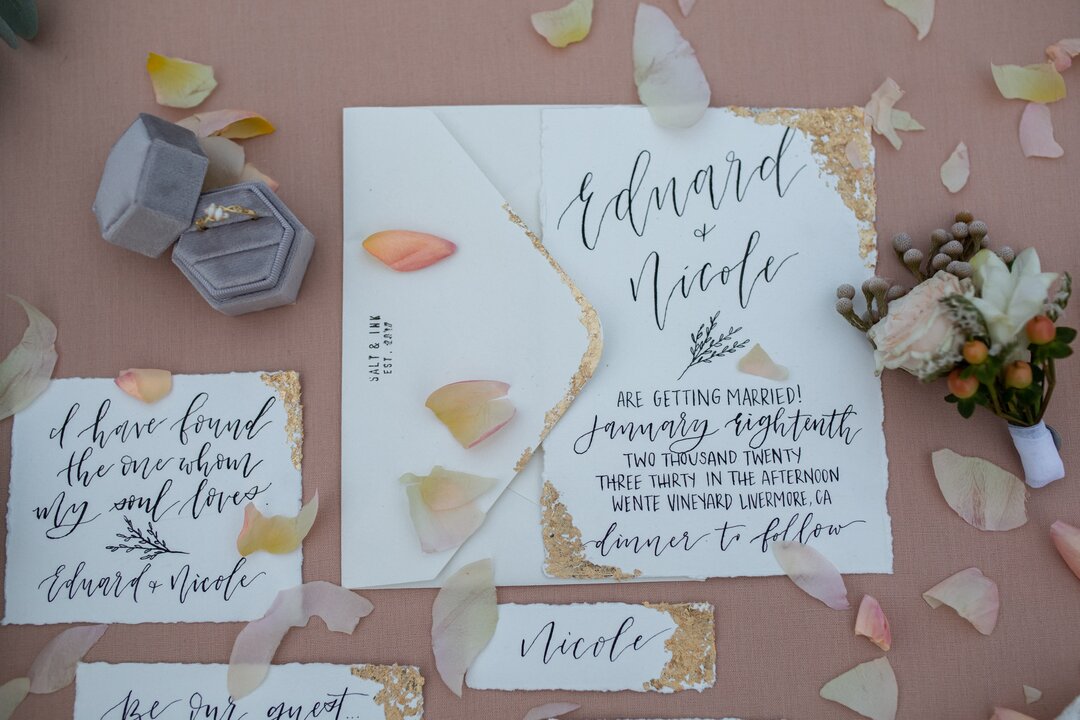- Expert advice/
- Invites & paper/
- Invitations/
- Top 11 Wedding Invitation Etiquette Mistakes to Avoid
- Invitations
Top 11 Wedding Invitation Etiquette Mistakes to Avoid
Find out everything you need to know about the wedding invitation etiquette mistakes you’ll want to avoid.
Last updated February 5, 2024

Addressing and sending your wedding invitations is an important part of the wedding planning process. But while it may seem simple, the truth is, there’s far more to wedding invitations than dropping cards off at the post office.
In fact, there are a slew of etiquette rules that need to be considered when sending invitations to your guests. From when they should be sent out to how best to deliver certain information, it can all get a bit complicated. To avoid any confusion or unintentional offenses, let’s take a look at the wedding invitation etiquette mistakes you’ll definitely want to avoid as you plan your wedding and get ready to start your life as a married couple:
1. Putting an Incorrect Start Time
You need your guests to show up to your wedding ceremony on time. But they can only do that if you put the correct time on your wedding invitation.
Make sure that you put your ceremony’s exactly start time (for example, 4 o’clock) on your invitation. Specify whether that time is AM or PM.
If your reception immediately follows your reception, it’s fine to just include the verbiage “reception to follow.” If there’s a gap between your ceremony and reception (for example, if your wedding ceremony is in the morning and your wedding reception doesn’t start until 5pm), you’ll want to include both times on your invite.
2. Not Including All the Necessary Information
Another major wedding invitation etiquette mistake? Not including all of the necessary information on your invitation.
What counts as “necessary information” will depend on your wedding. All wedding invitations should include the bride’s name and/or groom’s name (both partners’ names should be on the invite!); the date, time, and location of the wedding; RSVP information, including an RSVP date and RSVP date cards; and invitation envelopes with a return address for people to RSVP. (If you’re doing an online RSVP through your wedding website, these envelopes are unnecessary.)
For a more traditional wedding or formal wedding, there may be additional wedding invitation information you want to include (for example, the couple’s middle names or a host line—like “the bride’s parents request the honor of your presence at the marriage of their daughter” or, if both sets of parents are hosting, “the parents request the pleasure of your company at the marriage of their children.”) For certain wedding guests, you may want to include an insert with additional information (for example, rehearsal dinner details for the wedding party and close family members).
The point is, there is information you need to include on your wedding invitation—and leaving that information off would be a mistake.
3. Not Sending an Invite to Someone You Know Can't Come
If you have someone in your life that you know for a fact can’t attend your wedding, you might think that you don’t need to send them an invitation.
But you would be wrong.
If someone doesn’t receive an invitation to your wedding, chances are, they’re going to assume you didn’t want to invite them—even if the reason you didn’t send the invitation is that you know they couldn’t attend.
To be safe, send an invitation to every single person on your wedding guest list—even if they’ve already said they can’t come. The extra invites might marginally increase the cost of your wedding invitation suite—but that small cost is more than worth it when you consider it will help you protect your relationships and avoid any potentially hurt feelings.
4. Not Having Someone Else Proofread the Invitation
A major wedding invitation etiquette no-no? Sending invites with mistakes—whether that’s spelling mistakes, grammar mistakes, invitation design mistakes, or informational mistakes.
Luckily, there is a quick and easy way to avoid sending out mistake-riddled invitations—and that’s having someone proofread your invites before you print and send them.
Ask someone that you know has impeccable attention to detail to give your invitations a once over before you print. That way, they can clue you in to any mistakes on the invitation—and you can correct those mistakes before you send the invitations to your guests.
5. Sending Them Too Late
One of the biggest wedding invitation mistakes is not letting your wedding guests know with enough advance as to when your big day will be. As a courtesy to your guests (and whoever’s a part of making your wedding happen), invitations should be sent out six to eight weeks beforehand, at the latest. This will give your guests enough time to double check their calendars and set up accommodations, if need be. If you’re having a destination wedding, send invitations out further in advance—we suggest twelve weeks. Also, if you have guests coming in from far and wide, consider sending them out earlier than the standard six to eight weeks prior. You can never give guests too much notice.
6. Not Including RSVP Instructions
Each of your invitation suites should include either an RSVP insert or RVSP information directly on the invitation. Included in this information is your RSVP deadline. Setting a realistic deadline is paramount when it comes to finalizing your wedding day details. Depending on the size and style of your wedding, the day you absolutely need a final headcount will vary. That being said, you’ll want to make it at least three to four weeks before your wedding date. Doing so gives you and your vendors (caterers, florists, and the like) enough leeway to get an accurate count and prepare any last-minute details accordingly.
Along with your deadline, let guests know how to RSVP. Include a pre-addressed and stamped envelope in your invitation suite so that they can mail back a reply, or direct them to a phone number, email address, or wedding website (if online RSVPing is an option) where they can respond.
7. Not Reminding Guests About the RSVP Deadline

If your deadline is approaching (or has passed) and you haven’t heard back from a few people, it’s completely appropriate to remind them. Before panicking, remember that everyone gets busy—and it’s nothing personal. Sometimes people just need a gentle reminder—and it’s perfect in line with wedding RSVP etiquette for you to send that reminder. Depending on how much time you have until your wedding, wait one to two weeks after your deadline to start nudging guests. At that point, you can go line by line down your guest list and start personally seeking out responses.
How you go about this depends on your relationship with each person. If someone’s a close friend or family member that you see often, simply ask them in person. For more distant relatives or friends that you don’t see as much, inquiring through a quick phone call, text, or email should do the trick. As for parents’ friends, or those with a similar connection, ask mom or dad (or whomever your mutual connection is) to reach out, as necessary.
Social media is even an option. For example, if you see someone who hasn’t responded yet posting on their Instagram stories, shoot them a DM. Just be sure to avoid any public pages or group messages that could reach friends (or followers) that weren’t invited.
8. Not Being Clear About Plus-Ones

Avoid awkward calls and emails asking about plus-ones by making it clear on your formal invitation as to whether or not someone gets the option of a guest. Do this by addressing invitations to exactly who’s invited. For example, if a sibling’s significant other is invited and you know his or her name (or you can ask for it), write it out alongside your sibling’s name. If you’re allowing certain guests a plus-one of their choosing, address the invitation to his or her name “and Guest.”
Another way that you can make plus-ones clear is by including, “___ seat(s) have been reserved in your honor” on your RSVP card. Write one if no plus-one is given, two if one plus-one is given, and so on. If you’re worried about people getting confused about the wedding invitation wording or bringing someone without asking, make it crystal clear. Have, “We can only accommodate the individual(s) named on the envelope. No plus-ones, unless clearly designated,” or similar printed on your RSVP card or an informational insert. Be as specific as possible when it comes to the invitation wording.
To recap:
- “John Doe and Jim Dear,” is appropriate if you’re inviting someone and a specific plus-one (ie. a significant other).
- “John Doe and Guest,” is appropriate if you’re giving someone a plus-one.
- “Two seats have been reserved in your honor,`” is appropriate on a RSVP insert if you’re giving someone a plus-one.
9. Not Properly Addressing Invitations for a Kid-Free Wedding and Reception
-
wedding invitation wording
-
inner envelope
-
outer envelope
If you’re planning a kid-free wedding, you need to be super clear with your guests. Leaving anything ambiguous is a major invitation mistake—and could lead to guests bringing their little ones to your wedding.
If you’re having a kid-free wedding reception, how you address your wedding invitations and the wording you use is super important. Be sure to properly and carefully address invitations. Avoid addressing envelopes to “The Doe Family” and, instead, address the parent or parents’ full names on both the inner envelope and outer envelope. You can also make this clear by writing or printing the exact names of the invited guests on the response card. What we discourage you from doing is putting “Adults Only” or “No Children” on your invitations. You shouldn’t feel guilty for planning a kid-free affair, but it isn’t tactful to state that outright. Instead, if you feel compelled to, clearly express this detail on your wedding website.
As a thoughtful gesture, consider hiring a babysitter where your guests are staying for the duration of your wedding.
10. Not Being Clear About the Dress Code
Everyone’s personal style is different, so it’s important that you’re clear about the level of formality you want at your wedding. There are two ways you can spread the word—on an insert within your invitation suite, or on your wedding website (if not both). Simply dedicate a space to detailing how you’d prefer your guests to dress. Remember to take the projected weather and your venue’s terrain into account.
Here’s a list of dress categories, from formal to least formal:
- White tie
- Black tie
- Formal
- Semi-formal
- Cocktail attire
- Destination (think beach or garden)
- Casual
11. Including Your Registry Information
Including your wedding registry on your formal invitation is a bit of a faux pas; however, including your wedding website URL is more widely accepted. This is because your website isn’t just a go-to for gifts, but rather a hub for everything that your guests should know leading up to your wedding. It can also link to your registry, so don’t worry—it’s a roundabout way of getting it out there. Just have an easy to locate registry tab or link on your website.
As for your website URL, there are a few places where you can share it. The most popular option is save the dates, but you can also place it on a details card, wedding website card, or RSVP card. Only opt for the latter if you’re making online RSVPing an option. A general rule of thumb: Before including your website link in your invitation suite, ask if it’s serving more of a purpose than broadcasting where guests can purchase gifts.
If you’re asking for cash, like your registry, don’t include this information directly on your wedding stationery. Instead, create one or several cash funds within your Zola registry. Since your registry is linked to your wedding website, guests will easily be able to locate them there. As a courtesy, be clear as to how you plan on spending the gifted money. For example, have cash funds dedicated to something broad, such as your honeymoon, or more specific, such as a certain excursion or activity. Guests will feel more comfortable (and excited) knowing what they’re contributing to.
Don’t be hesitant to use word of mouth, either. Tell your friends and family (either in person or over the phone) that you’re registering for cash funds and offer details about what it’ll go towards. Your guests want to gift you what you want—especially if they hear it straight from the source.
Now that you know all things invitation etiquette, it’s time to get to work on your invitations. Don’t worry, we have all of your do’s and don’ts already laid out.
- Expert advice/
- Invites & paper/
- Invitations/
- Top 11 Wedding Invitation Etiquette Mistakes to Avoid
Find even more wedding ideas, inspo, tips, and tricks
We’ve got wedding planning advice on everything from save the dates to wedding cakes.
